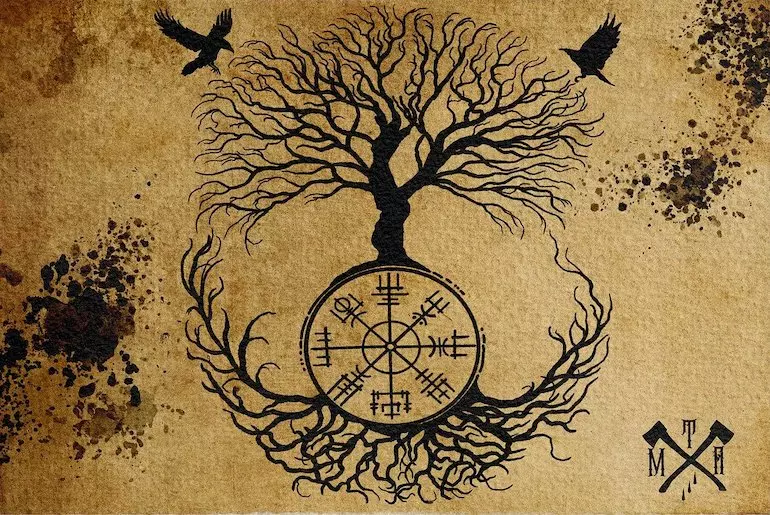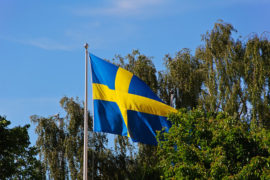If you believe the old stereotypes, Vikings were violent seafarers who made their enemies shudder. But did they really have big tattoos that made them extra scary?

Nowadays, loads of people are asking if Vikings actually had tattoos, including fans of the hit TV series Vikings on Netflix, where the actors have no shortage of gnarly tattoos.
The sight of tattooed warriors in that show (and others) has sparked curiosity about whether Vikings really got themselves inked up before battle.
Let’s take a look at the historical evidence to see if tattoos really were a significant part of Viking culture. And if you’re thinking about getting yourself a ‘Viking’ tattoo, we’ll also give you some pointers on what to go for – and what to avoid!
Why get a Viking tattoo?
There are lots of reasons why you might want to get a Viking-inspired tattoo.
Viking-style tattoos can hold a lot of meaning, whether you’re paying homage to your ancestral heritage, embodying the adventurous nature of the Vikings, or simply appreciating the aesthetics of Viking art. With so much depth and allure, what’s not to love?
However, there are some things to keep in mind when it comes to getting a Viking tattoo.
Capturing an authentic and meaningful Viking design can be a complex undertaking, given the scarcity of concrete historical evidence to support the idea that Vikings really had tattoos..
And here’s another important thing to bear in mind: certain symbols associated with Viking culture have, unfortunately, been appropriated by far-right groups.
What’s the evidence of Vikings having tattoos?
During the Viking era, which spanned the late 8th to the 11th century, the Vikings led a seafaring lifestyle marked by exploration, raids and trading.
While much is known about the culture and lifestyle of the Vikings, it’s incredibly hard to know whether they really had tattoos. For starters, there aren’t any Viking remains that are well preserved enough to show tattoos.
However, there is one notable testimony of tattooed Vikings. The account comes from the 10th-century Arab traveler Ahmad ibn Fadlan, who encountered a group of Viking traders along the Volga River.
Ibn Fadlan described the extensive markings on their bodies, suggesting the presence of tattoos or some kind of body paint on some of the Vikings he saw.
While this testimony provides a tantalizing glimpse into Viking tattoo practices, it is important to approach it with critical analysis and consider it within the broader context of Viking culture and history.
Tattooing techniques and materials
So, if Vikings did have tattoos, the question arises: how might they have gone about creating these inked works of art? Even though the evidence is limited, we can still speculate on the techniques that Vikings potentially used.

Considering the tools and resources available during their time, it is likely that they used methods such as hand-tapping or hand-poking, involving the puncturing of the skin with a needle or sharp instrument and rubbing pigment into the wounds.
The natural inks used for their tattoos could have been crafted from a combination of ash, derived from burnt wood or bones, along with substances like kohl and various plant-based materials.
Sounds painful? Well, yes! The rugged blades and lack of anaesthetics during the Viking era suggests that tattooing was likely a rather “ouch” experience.
But fear not, for the Vikings were not just fierce warriors, they were also quite clever!
In their quest for a more comfortable tattooing session, it is plausible that they turned to their knowledge of medicinal plants.
They might have used certain plants with natural numbing properties to help take the edge off the pain.
But what colour were Viking tattoos? Considering they used earthy materials, it is likely that traditional Viking tattoos featured tones such as black, deep brown and possibly shades of green, creating a connection to the natural world they revered.
Popular Viking tattoo designs
If you’re thinking about getting a Viking-inspired tattoo, you’ll find a variety of captivating designs that are influenced by the rich symbolism of Norse mythology. But, what do Viking tattoos mean?
Read on to find out all about a few traditional Viking tattoos and their meanings.
Helm of Awe
An eight-armed symbol of mystery and power, the Helm of Awe was believed to provide spiritual fortitude and fearlessness in battle.

Furthermore, it symbolizes dominance in battle and signifies the power to instill fear in others while conquering one’s own fears.
Yggdrasil
Also called the Tree of Life, Yggdrasil symbolises the interconnectedness of the Norse cosmos and everything in it. It can convey a sense of harmony, balance and the enduring nature of existence.

Thor’s Hammer (Mjolnir)
The iconic hammer of the thunder god Thor, Mjolnir symbolizes protection, strength and divine blessings. It can be seen as a representation of power and courage in modern tattoo designs.
Huginn and Muninn
Huginn and Muninn are associated with two ravens, symbolizing wisdom, knowledge and observation. They are also often depicted as messengers for Odin, the Norse god of war and wisdom.

Ouroboros
A serpent or dragon eating its own tail, the Ouroboros symbolizes eternal cycles and the concept of infinity. The intricate details of the Ouroboros, with its scales and swirling patterns, would make for a visually captivating and thought-provoking tattoo design.
Troll Cross
A protective charm against evil spirits and creatures, the Troll Cross represents defence and warding off negative forces. It can serve as protection in modern tattoo designs.
Web of Wyrd
The Web of Fate represents the belief that “everything in life is interconnected”.
The captivating tattoo design of the Web of Fate is believed to be woven by the three Norns who were ancient beings that shaped the destinies of all beings in the cosmos. Cool, right?
Gungnir
Gungnir is associated with the spear of Odin, which symbolizes divine power. It can be used in tattoo designs to convey strength, leadership, and a sense of purpose.
Runes
A good choice if you’re looking for small Viking tattoos, the Nordic runes hold individual meanings and can be combined to convey personal messages or intentions.
Each rune carries its own symbolism, so this could be great for those who want an extra-personalized tattoo!
Other popular designs
Besides all the above ideas, which are all great choices, maybe you’re inspired to create a custom Viking tattoo design that incorporates multiple symbols or personal elements. If so, you’re in luck!
You could get a Viking ship tattoo, symbolizing the adventurous spirit and seafaring legacy of the Vikings. Or why not consider Viking tribal tattoos, or a depiction of a Viking warrior, capturing their strength and bravery.
Did Viking women have tattoos?
While direct evidence is scarce, there is speculation and some evidence to suggest that Viking women might have had tattoos.
Certain historical accounts and archaeological findings, though not conclusive, hint at the possibility of tattooed Viking women.
However, the extent and significance of these tattoos remain uncertain, emphasizing the need for further research to shed more light on the presence and cultural context of tattoos among Viking women.
Did Vikings have head tattoos?
Evidence suggests that no, Vikings most likely did not have tattoos on their heads. Ibn Fadlan described that the Vikings’ markings spanned from their fingertips to the back of their necks.
So Viking skull tattoos and Viking face tattoos seem unlikely. While tattoos may have been a prominent feature for Vikings, it appears that they focused their body art on areas other than their heads.
Viking finger tattoos, Viking leg tattoos and Viking hand tattoos all appear to be more plausible options.
Viking tattoos to avoid
In recent times, some Viking symbols have been co-opted by far-right groups, leading some to ask whether Viking tattoos are racist and best avoided altogether.
The answer is that Viking tattoos are not racist, per se. But it’s important to be mindful of the misuse of Viking symbols by these right-wing groups. Some of the symbols, like the Valknut (which actually represents the cycle of life and death) have been adopted by – and indeed tattooed on – members of these groups.
Another example of a Viking tattoo to avoid is the Fenrir symbol (the giant wolf), which has been used by some neo-nazi groups.
Beyond any potentially nasty links, it’s also crucial to understand the historical context of Viking symbols and avoid using them without proper knowledge and respect.
Viking symbols are deeply rooted in Norse mythology and could hold significance to communities that identify with that culture, like Norse pagans.
Getting Viking symbols as tattoos without really understanding their meaning and historical context can lead to misrepresentation or appropriation, which some might find offensive or disrespectful. So research carefully before getting inked, and enjoy wondering whether the real Vikings ever had tattoos!
See also:
Viking tattoos and thier inspiration
What is the Vegvisir symbol?
Viking runes and their meanings










I just stumbled across this, but I want to make it very clear that plenty of these symbols are NOT Norse. The Aegishjalmur or “Helm of Awe” symbol first appears in the 1600s, an entire 600 years after the end of the Viking Age. While the Helm DOES appear in written texts, the symbol itself does not. The Vegvisir appears in the 1800s, and how it got connected to the Viking Age I will never understand. As for the Valknut, it was likely borrowed from a symbol on Anglo-Saxon coins. While it does appear in the Viking Age, its meaning… Read more »